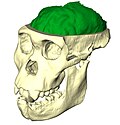Paleoneurobiology
Paleoneurobiology is a scientific discipline that combines aspects of paleontology, neuroscience, and biology to study the evolution of the nervous system in prehistoric organisms. This field of study uses various methods to examine the brain structure and function of extinct species, providing insights into the evolutionary history of the nervous system.
History[edit]
The field of paleoneurobiology emerged in the late 19th century, with early pioneers such as Ralph L. Holloway and Harry Jerison contributing significantly to its development. The discipline has evolved over time, incorporating new technologies and methodologies to enhance the study of ancient nervous systems.
Methodology[edit]
Paleoneurobiology utilizes a variety of techniques to study the nervous systems of extinct species. These include endocast studies, where the internal structure of a fossilized skull is used to create a three-dimensional model of the brain, and computed tomography (CT) scans, which provide detailed images of the internal structures of fossils.
Findings[edit]
Paleoneurobiology has provided significant insights into the evolution of the nervous system. For example, studies have shown that the brains of dinosaurs were more complex than previously thought, with certain species exhibiting advanced cognitive abilities. Additionally, research in this field has shed light on the evolution of the human brain, revealing that our ancestors had larger brains relative to their body size than previously believed.
Challenges[edit]
Despite its many advancements, paleoneurobiology faces several challenges. These include the rarity of well-preserved fossils, the difficulty in interpreting endocast data, and the limitations of current imaging technologies.
Future Directions[edit]
The future of paleoneurobiology is promising, with advancements in technology expected to enhance the study of ancient nervous systems. For instance, the development of more sophisticated imaging techniques could provide more detailed insights into the structure and function of extinct species' brains.

This article is a paleontology stub. You can help WikiMD by expanding it!

This article is a neuroscience stub. You can help WikiMD by expanding it!
-
Endocast of Australopithecus sediba
-
Primate skull series with legend
-
Head CT scan
-
MRI EGC sagittal
Ad. Transform your life with W8MD's Budget GLP-1 injections from $75


W8MD offers a medical weight loss program to lose weight in Philadelphia. Our physician-supervised medical weight loss provides:
- Weight loss injections in NYC (generic and brand names):
- Zepbound / Mounjaro, Wegovy / Ozempic, Saxenda
- Most insurances accepted or discounted self-pay rates. We will obtain insurance prior authorizations if needed.
- Generic GLP1 weight loss injections from $75 for the starting dose.
- Also offer prescription weight loss medications including Phentermine, Qsymia, Diethylpropion, Contrave etc.
NYC weight loss doctor appointmentsNYC weight loss doctor appointments
Start your NYC weight loss journey today at our NYC medical weight loss and Philadelphia medical weight loss clinics.
- Call 718-946-5500 to lose weight in NYC or for medical weight loss in Philadelphia 215-676-2334.
- Tags:NYC medical weight loss, Philadelphia lose weight Zepbound NYC, Budget GLP1 weight loss injections, Wegovy Philadelphia, Wegovy NYC, Philadelphia medical weight loss, Brookly weight loss and Wegovy NYC
|
WikiMD's Wellness Encyclopedia |
| Let Food Be Thy Medicine Medicine Thy Food - Hippocrates |
Medical Disclaimer: WikiMD is not a substitute for professional medical advice. The information on WikiMD is provided as an information resource only, may be incorrect, outdated or misleading, and is not to be used or relied on for any diagnostic or treatment purposes. Please consult your health care provider before making any healthcare decisions or for guidance about a specific medical condition. WikiMD expressly disclaims responsibility, and shall have no liability, for any damages, loss, injury, or liability whatsoever suffered as a result of your reliance on the information contained in this site. By visiting this site you agree to the foregoing terms and conditions, which may from time to time be changed or supplemented by WikiMD. If you do not agree to the foregoing terms and conditions, you should not enter or use this site. See full disclaimer.
Credits:Most images are courtesy of Wikimedia commons, and templates, categories Wikipedia, licensed under CC BY SA or similar.
Translate this page: - East Asian
中文,
日本,
한국어,
South Asian
हिन्दी,
தமிழ்,
తెలుగు,
Urdu,
ಕನ್ನಡ,
Southeast Asian
Indonesian,
Vietnamese,
Thai,
မြန်မာဘာသာ,
বাংলা
European
español,
Deutsch,
français,
Greek,
português do Brasil,
polski,
română,
русский,
Nederlands,
norsk,
svenska,
suomi,
Italian
Middle Eastern & African
عربى,
Turkish,
Persian,
Hebrew,
Afrikaans,
isiZulu,
Kiswahili,
Other
Bulgarian,
Hungarian,
Czech,
Swedish,
മലയാളം,
मराठी,
ਪੰਜਾਬੀ,
ગુજરાતી,
Portuguese,
Ukrainian



